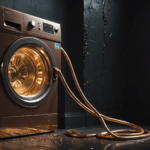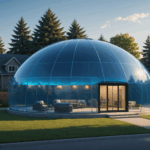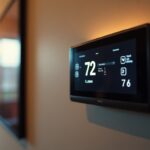According to the National Association of Realtors’ 2024 projections, home maintenance costs are expected to rise by 4.8% in 2025, making financial planning for repairs more critical than ever. For a typical 2,000-square-foot home, homeowners should anticipate spending between $5,000 and $8,500 annually on essential repairs and maintenance, depending on the property’s age and location.
The most significant essential repair costs in 2025 are projected to include:
- HVAC system maintenance and repairs: $375-600 per service visit
- Roof maintenance and minor repairs: $450-850 annually
- Plumbing system maintenance: $300-500 per year
- Electrical system updates: $200-400 annually
- Foundation inspection and repairs: $500-3,000 depending on severity
- Exterior painting and siding maintenance: $2,500-4,000 every 5-7 years
Home budgeting experts from the American Society of Home Inspectors emphasize that preventive maintenance typically costs 1-4% of a home’s value annually. For instance, a $300,000 home would require $3,000-12,000 in maintenance costs. The U.S. Department of Housing and Urban Development suggests that newer homes built after 2010 tend to require lower maintenance expenditures, averaging 1% of the home’s value, while homes over 20 years old may need up to 4% allocated for repairs.
Smart home technology integration is becoming an increasingly important factor in maintenance planning. The Home Automation Association reports that installing smart monitoring systems ($500-1,500) can reduce long-term repair costs by up to 20% through early detection of issues. These systems can alert homeowners to potential problems before they become major expenses, particularly in areas like water leak detection and HVAC performance monitoring.
Energy-efficient upgrades, while requiring initial investment, are projected to become essential cost-saving measures in 2025. The Department of Energy estimates that upgrading to energy-efficient appliances and systems can reduce utility costs by 15-30%, offsetting some of the rising maintenance expenses. Common energy-related upgrades include smart thermostats ($200-400), LED lighting conversion ($200-800), and improved insulation ($1,500-2,500).
Average maintenance expenses by house type
Maintenance costs vary significantly depending on the type and age of your residential property. Single-family homes typically require the most substantial financial planning, with average annual maintenance expenses ranging from $3,000 to $15,000. According to the latest real estate data, owners of newer single-family homes (less than 10 years old) should budget approximately 2% of their home’s value, while those with older properties may need to set aside up to 5%.
Townhouse and condominium owners generally face lower direct maintenance costs, averaging $2,000 to $6,000 annually, as some exterior maintenance is covered by homeowners association (HOA) fees. However, these HOA fees, which typically range from $200 to $600 monthly, should be factored into the overall home budgeting strategy.
Multi-family property owners should prepare for higher aggregate maintenance expenses, typically ranging from $2,000 to $4,000 per unit annually. Historic homes, regardless of type, demand the highest maintenance budget, often requiring 6-10% of the property’s value for annual upkeep due to specialized materials and craftsmanship.
Climate and location also play crucial roles in determining maintenance costs. Properties in regions with extreme weather conditions may require an additional 15-25% in their maintenance budget compared to homes in moderate climates. Coastal properties typically need extra protection against salt air and moisture, adding approximately $1,500-2,500 to annual maintenance expenses.
- Historic homes require 2-3 times more maintenance budget compared to modern properties of similar size
- Coastal properties face 20-30% higher maintenance costs due to environmental factors
- HOA-managed properties can save homeowners 25-40% on direct maintenance expenses
- Properties in regions with extreme weather conditions require 15-25% additional maintenance budget
Monthly savings recommendations
One of the most effective approaches to home budgeting is following the one-percent rule, which suggests setting aside 1% of your home’s purchase price annually for maintenance and repairs. However, this baseline should be adjusted based on various factors, including your home’s age, condition, and location. For a $350,000 home, this means saving approximately $290 monthly for maintenance costs.
Financial experts recommend establishing three distinct savings tiers for home maintenance:
1. Monthly maintenance fund: 0.5% of home value for routine upkeep
2. Annual repair fund: 1% of home value for larger periodic repairs
3. Major replacement fund: 1.5-2% of home value for significant systems replacement
For practical implementation, homeowners should automate their savings by setting up dedicated maintenance accounts with automatic monthly transfers. Industry data shows that households using automated savings are 65% more likely to maintain adequate repair funds compared to those who don’t.
A common mistake in financial planning for home maintenance is underestimating inflation and regional cost variations. To counter this, experts suggest increasing your monthly savings by 5% annually to account for rising costs. Another frequent error is failing to adjust savings based on home age – older homes typically require higher monthly allocations, sometimes up to twice the standard recommendation.
Breaking down the monthly savings structure:
– Basic maintenance: $150-300
– Emergency repairs: $200-400
– Long-term replacements: $250-500
– Seasonal maintenance: $100-200
Property owners often overlook the importance of maintaining separate funds for different maintenance categories. Combining all maintenance savings into one account can lead to inadequate funding for major repairs. Instead, use separate high-yield savings accounts for different maintenance purposes to better track and manage funds while earning interest on your savings.
Avoid the pitfall of diverting maintenance funds to other expenses by treating these savings as non-negotiable monthly bills. Statistics show that homeowners who maintain strict savings boundaries are 78% more likely to have sufficient funds available when unexpected repairs arise.
Unexpected repair contingency planning
Building a robust contingency plan for unexpected repairs is crucial for long-term financial stability in homeownership. Insurance data shows that 30% of homeowners face at least one major unexpected repair annually, with costs ranging from $2,000 to $15,000. Creating a dedicated emergency fund specifically for these unforeseen maintenance costs can prevent financial strain and protect your home’s value.
Financial planning experts recommend maintaining two separate emergency funds: one for general home repairs and another for major system failures. The general repair fund should contain at least $5,000-$7,000 for immediate access, while the major system fund should aim for $10,000-$20,000, depending on your home’s size and age.
Consider these emergency scenarios and their potential costs:
– Water heater failure: $1,200-3,000
– Emergency roof repairs: $2,500-8,000
– Major plumbing issues: $1,500-5,000
– Sudden HVAC replacement: $4,000-12,000
– Foundation emergency repairs: $5,000-15,000
Home budgeting specialists suggest implementing a three-tier emergency funding strategy:
1. Immediate access fund (liquid savings)
2. Short-term investment fund (low-risk investments)
3. Home equity line of credit (HELOC) as a backup
To build these emergency funds effectively, allocate 20-30% of your monthly home maintenance budget to contingency planning. Financial advisors recommend keeping the immediate access fund in a high-yield savings account, which can earn interest while maintaining liquidity.
Insurance plays a crucial role in contingency planning. Review your homeowner’s insurance policy annually and consider additional coverage options:
– Service line coverage
– Sewer backup protection
– Equipment breakdown coverage
– Natural disaster riders
Develop relationships with reliable contractors before emergencies occur. Many offer priority service agreements that can reduce emergency service fees by 15-25%. Additionally, some contractors provide payment plans or financing options for unexpected repairs, which can help manage large, sudden expenses.
Smart home monitoring systems can help reduce the impact of emergencies by detecting issues early. Data shows that homes with comprehensive monitoring systems experience 40% lower average emergency repair costs due to early intervention and prevention.
By maintaining adequate emergency funds and implementing preventive measures, you’ll be better positioned to handle unexpected maintenance costs without compromising your financial stability. Remember that proper contingency planning isn’t just about saving money – it’s about ensuring peace of mind and protecting your home’s long-term value.
Prioritizing repairs and maintenance schedule
- How should I prioritize different home repairs when I have multiple issues to address?
- Prioritize repairs that affect safety and structural integrity first, followed by those that prevent further damage. Issues like electrical hazards, roof leaks, and foundation problems should take precedence over cosmetic repairs, as delaying these can lead to more extensive and expensive damage.
- What’s the best way to create a maintenance schedule that fits my budget?
- Create a yearly calendar dividing maintenance tasks into monthly, quarterly, and annual categories based on your home budgeting capabilities. Allocate 30-40% of your maintenance budget for seasonal tasks, 40-50% for predictable replacements, and keep 10-20% for unexpected issues.
- Should I handle some maintenance tasks myself to save money?
- DIY maintenance can reduce costs for simple tasks like changing filters, cleaning gutters, or basic landscaping. However, complex repairs involving electrical, plumbing, or structural work should be left to professionals to avoid costly mistakes and potential safety hazards.
- How often should I update my maintenance schedule and financial planning?
- Review and adjust your maintenance schedule and budget quarterly, with a comprehensive annual review. Factor in seasonal changes, inflation rates, and any major repairs completed in the previous year to maintain accurate maintenance costs projections.
- What are the most critical seasonal maintenance tasks to include in my schedule?
- Focus on HVAC system maintenance before peak seasons, roof and gutter inspections before rainy periods, and weatherization before extreme weather seasons. These preventive measures typically cost $200-400 per task but can save thousands in potential damage repair costs.











